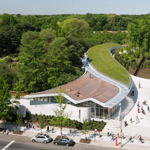 Grown in Detroit
Grown in Detroit
September/October 2013
Growing up in the northwest suburbs of Detroit, I never believed cities were places where people lived. Ruins like the Michigan Central Station in Corktown, an incongruous three-story train depot and 18-story office tower fronted by stone archways and Corinthian columns, were relics of another era. Wind whistled through shattered windows. Scrappers found their way around razor wire to pillage brass fixtures, copper wire, ceiling rosettes, and hunks of marble. There were stories of squatters living inside on mattresses. If this was living, it was at best provisional. Continue reading.
 Edge Condition
Edge Condition
March/April 2013
While Central Park sits in the center of Manhattan like a defiant, 843-acre glimpse into a world that might be, the new visitor center at the comparatively diminutive 52-acre Brooklyn Botanic Garden welcomes the public to a version of New York City as it is meant to be. With its lanceolate living roof, curving glass walls, and 42,000 square feet of freshly planted landscape, the $28 million, 22,000-square-foot visitor center, as designed by Weiss/Manfredi Architecture/Landscape/Urbanism and completed in May 2012, responds to the ongoing gentrification of Brooklyn by conciliating the city’s diverse ecological past with its rapidly evolving urban future. Continue reading.
 The Promise of the Community College
The Promise of the Community College
July/August 2013
Ninety percent of the US population lives within 25 miles of a community college. There are nearly 1,200 of them scattered across the nation, and they serve 46 percent of all undergrads in the United States, providing an affordable, accessible path to higher education, no matter their socioeconomic status, educational background, or citizenship. Continue reading.
 Living Architecture: Five Growing Trends
Living Architecture: Five Growing Trends
September/October 2013
We can easily call this the green era of architecture, but for many, the descriptor owes itself more to a philosophy and less to the color. Living architecture and associations such as Green Roofs for Healthy Cities (GRHC) are changing that by painting our cities with increasingly complex plant ecologies. Although vegetated roofs and walls vary from project to project and city to city, and though they are not one but many things, serving different objectives, meeting dissimilar expectations, and answering varied practical realities—including, simply, what can grow where—as experts and advocates explain, five new trends make the case for a strong and vibrant future. Continue reading.
 What Can We Green by Greenbuild?
What Can We Green by Greenbuild?
November/December 2013
At their best, industry conferences are the perfect backdrop for rubbing elbows and sharing best practices with your peers. But even when performing at this ideal level, conferences have a tendency toward self-congratulations, which often work against the industry’s best intentions. In an attempt to correct this, and set a new standard for what a green building conference can do, the Delaware Valley Green Building Council (DVGBC), the host chapter for this year’s Greenbuild International Conference and Expo in Philadelphia, launched a challenge to unite the greater community of the Delaware Valley by pledging to “green” itself by November 2013. Continue reading.

